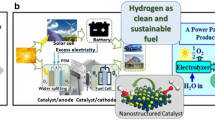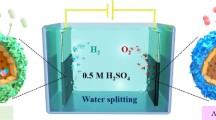Abstract
The dry reformate and wet reformate operations of solid oxide fuel cell (SOFC) with 200 nm-thick, nanoporous Ni thin-film anode were investigated in terms of power performance at 500°C. The initial power density of the SOFC fueled with dry reformate (H2 75%, CO 10%, CO2 10%, CH4 5%) was 5% lower than that of the SOFC fueled with H2, which was almost similar to that of the SOFC fueled with wet reformate humidified by water bubbling at room temperature. The reduction rate in power density of the SOFC fueled with the dry reformate was as high as 6%/hr; the reduction rate in power density of the SOFC fueled with the wet reformate was decreased by 55% through carbon poisoning alleviation of the Ni thin-film anode.









Similar content being viewed by others
References
Lee, Y. H., Chang, I., Cho, G. Y., Park, J., Yu, W., Tanveer, W. H., & Cha, S. W. (2018). Thin film solid oxide fuel cells operating below 600°C: a review. International Journal of Precision Engineering and Manufacturing-Green Technology, 5(3), 441–453.
Choi, H., Cho, G. Y., & Cha, S. W. (2014). Fabrication and characterization of anode supported YSZ/GDC bilayer electrolyte SOFC using dry press process. International Journal of Precision Engineering and Manufacturing-Green Technology, 1(2), 95–99.
Ji, S., & Kim, W. (2022). Is coating oxide on porous metal thin-film for low-temperature solid oxide fuel cell cathode a panacea for performance enhancement? International Journal of Precision Engineering and Manufacturing, 23(4), 445–451.
Karimaghaloo, A., Koo, J., Kang, H.-S., Song, S. A., Shim, J. H., & Lee, M. H. (2019). Nanoscale surface and interface engineering of solid oxide fuel cells by atomic layer deposition. International Journal of Precision Engineering and Manufacturing-Green Technology, 6(3), 611–628.
Shim, J. H., Han, G. D., Choi, H. J., Kim, Y., Xu, S., An, J., et al. (2019). Atomic layer deposition for surface engineering of solid oxide fuel cell electrodes. International Journal of Precision Engineeringand Manufacturing-Green Technology, 6(3), 629–646.
Tanveer, W. H., Ji, S., Yu, W., & Cha, S. W. (2015). Characterization of atomic layer deposited and sputtered yttria-stabilized-zirconiathin films for low-temperature solid oxide fuel cells. International Journal of Precision Engineering and Manufacturing, 16(10), 2229–2234.
Ji, S. (2020). Thickness determination of a solid oxide fuel cell blocking layer prepared by atomic layer deposition considering the non-uniform surface geometry of porous substrate. International Journal of Precision Engineering and Manufacturing, 21(6), 1085–1090.
Ji, S., Kim, Y., & Cha, S. W. (2022). Operating cost savings in the atomic layer deposition process of ultrathin electrolyte for solid oxide fuel cells by applying oxygen plasma. International Journal of Precision Engineering and Manufacturing, 23, 573–579.
Ji, S., Ha, J., Park, T., Kim, Y., Koo, B., Kim, Y. B., An, J., & Cha, S. W. (2016). Substrate-dependent growth of nanothin film solid oxide fuel cells toward cost-effective nanostructuring. International Journal of Precision Engineering and Manufacturing, 3, 35–39.
Yu, W., Ryu, S., Tanveer, W. H., Cho, G. Y., & Cha, S. W. (2020). Effects of microstructure of Ni anode on nanotemplate based low temperature solid oxide fuel cells, 21(11), 2199–2208.
Cho, G. Y., Yu, W., Lee, Y. H., Lee, Y., Tanveer, W. H., Kim, Y., et al. (2020). Effects of nanoscale PEALD YSZ interlayer for AAO based thin film solid oxide fuel cells. International Journal of Precision Engineering and Manufacturing-Green Technology, 7(2), 423–430.
Ji, S., Seo, H. G., Lee, S., Seo, J., Lee, Y., Tanveer, W. H., Cha, S. W., & Jung, W. (2017). Integrated design of a Ni thin-film electrode on a porous alumina template for affordable and high-performance low-temperature solid oxide fuel cells. RSC Advances, 7, 23600–23606.
Ji, S., Tanveer, W. H., Yu, W., Kang, S., Cho, G. Y., Kim, S. H., An, J., & Cha, S. W. (2015). Surface engineering of nanoporous substrate for solid oxide fuel cells with atomic layer-deposited electrolyte. Beilstein Journal of Nanotechnology, 6, 1805–1810.
Gao, Y., Jiang, J., Meng, Y., Yan, F., & Aihemaiti, A. (2018). A review of recent developments in hydrogen production via biogas dry reforming. Energy Conversion and Management, 171, 133–155.
Lee, D., Myung, J., Tan, J., Hyun, S.-H., Irvine, J. T. S., Kim, J., & Moon, J. (2017). Direct methane solid oxide fuel cells based on catalytic partial oxidation enabling complete coking tolerance of Ni-based anodes. Journal of Power Sources, 345, 30–40.
Welander, M. M., Hu, B., & Tucker, M. C. (2022). Metal-supported solid oxide fuel cells operating with reformed natural gas and sulfur. International Journal of Hydrogen Energy, 47, 11261–11269.
Ma, J., Jiang, C., Conor, P. A., Cassidy, M., & Irvine, J. T. S. (2015). Highly efficient, coking-resistant SOFCs for energy conversion using biogas fuels. Journal of Materials Chemistry A, 3, 19068.
Chang, Y., Qin, Y., Yin, Y., Zhang, J., & Li, X. (2018). Humidification strategy for polymer electrolyte membrane fuel cells - a review. Applied Energy, 230, 643–662.
Seo, H. G., Ji, S., Seo, J., Kim, S., Koo, B., Choi, Y., Kim, H., Kim, J. H., Kim, T.-S., & Jung, W. (2020). Sintering-resistant platinum electrode achieved through atomic layer deposition for thin-film solid oxide fuel cells. Journal of Alloys and Compounds, 835, 155347.
Homel, M., Gur, T. M., Koh, J. H., & Virkar, A. V. (2010). Carbon monoxide-fueled solid oxide fuel cell. Journal of Power Sources, 195, 6367–6372.
Zhao, X., Joseph, B., Kuhn, J., & Ozcan, S. (2020). Biogas reforming to syngas: a review. iScience, 23, 101082.
Keipi, T., Tovanen, H., & Konttinen, J. (2018). Economic analysis of hydrogen production by methane thermal decomposition: comparison to competing technologies. Energy Conversion and Management, 159, 264–273.
Ji, S., Chang, I., Lee, Y., Park, J., Paek, J., Lee, M. H., & Cha, S. W. (2013). Fabrication of low-temperature solid oxide fuel cells with a nanothin protective layer by atomic layer deposition. Nanoscale Research Letters, 8, 48.
Ji, S., Cho, G. Y., Yu, W., Su, P.-C., Lee, M. H., & Cha, S. W. (2015). Plasma-enhanced atomic layer deposition of nanoscale yttria-stabilized zirconia electrolyte for solid oxide fuel cells with porous substrate. ACS Applied Materials & Interfaces, 7(5), 2998–3002.
Takahashi, H., Takeguchi, T., Yamamoto, N., Matsuda, M., Kobayashi, E., & Ueda, W. (2011). Effect of interaction between Ni and YSZ on coke deposition during steam reforming of methane on Ni/YSZ anode catalysts for an IR-SOFC. Journal of Molecular Catalysis A: Chemical, 350, 69–74.
Golkhatmi, S. Z., Asghar, M. I., & Lund, P. D. (2022). A review on solid oxide fuel cell durability: latest progress, mechanisms, and study tools. Renewable and Sustainable Energy Reviews, 161, 112339.
Vogt, C., Kranenborg, J., & Weckhuysen, B. M. (2020). Structure sensitivity in steam and dry methane reforming over nickel: activity and carbon formation. ACS Catalysis, 10, 1428–1438.
Acknowledgements
This work was supported by the Korea Institute of Civil Engineering and Building Technology Projects (No. 20220081, 20220232) and the National Research Foundation of Korea Project (No. NRF-2018R1D1A1B07048082, NRF-2021M3H4A3A02086498).
Author information
Authors and Affiliations
Corresponding author
Ethics declarations
Conflict of interest
On behalf of all authors, the corresponding author states that there is no conflict of interest.
Additional information
Publisher's Note
Springer Nature remains neutral with regard to jurisdictional claims in published maps and institutional affiliations.
Rights and permissions
Springer Nature or its licensor (e.g. a society or other partner) holds exclusive rights to this article under a publishing agreement with the author(s) or other rightsholder(s); author self-archiving of the accepted manuscript version of this article is solely governed by the terms of such publishing agreement and applicable law.
About this article
Cite this article
Ji, S., Kim, W., Han, S. et al. Stability Enhancement of Reformate-Fueled, Low-Temperature Solid Oxide Fuel Cell with Nickel Thin-Film Anode by Water Bubbling. Int. J. of Precis. Eng. and Manuf.-Green Tech. 10, 999–1006 (2023). https://doi.org/10.1007/s40684-022-00484-2
Received:
Revised:
Accepted:
Published:
Issue Date:
DOI: https://doi.org/10.1007/s40684-022-00484-2




